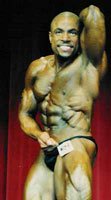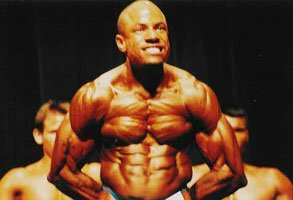When you walk out onto the stage this year, you hope that you have done everything to be (and look) your best. From the tips of your rounded shoulders to your crisply-defined calf muscles, you hope to have achieved that "complete package".
 To be anything more would seem to take something just short of a miracle. Or will it? Every bodybuilder seeks that so-called "Six Degrees of Separation". But not the one you're thinking of...
To be anything more would seem to take something just short of a miracle. Or will it? Every bodybuilder seeks that so-called "Six Degrees of Separation". But not the one you're thinking of...
The separations I'm referring to are the same ones that some call being "sliced", "cut", or "chiseled". The areas of the body that many bodybuilders attempt to "separate" are:
- Quadriceps
- Abdominals
- Hamstrings
- Calves
- Glutes
- Delts
In this article, I am going to provide you with my approach to maximum separation. How do you get there? How do you achieve maximum separation? Well, please read on. The three facets are dieting, training, and stretching.

Dieting For Separation
Your pre-contest diet will be the first determining factor when trying to achieve any degree of separation. Bodybuilders, sooner or later, realize how critical the "right" diet is in maximizing results.
I have found that a pre-contest diet (2-3 weeks out) that is roughly 2350 calories/day with a carb-fat-protein ratio of 8-10% carbs, 5-10% fat, and 90-95% protein is optimal for maximum separation. (These percentages are approximate, and may not exactly add up to 100.)
Although this type of nutrition is not recommended for a lengthy period, it can mean a dramatic change in a short amount of time. It is important for me to say that your diet is "fully" dependent on your current goal and conditioning.

Training For Separation
There are several concepts of training for separation. The two techniques I have seen and experienced success with are:
- High reps with moderate weight
- Ballistic training
I lean more towards a sadistic type of high-rep training. The infamous 100-rep approach! I believe this is the best and most demanding of all attempts at "Six Degrees of Separation".
 100-Rep Approach
100-Rep Approach
The 100-rep routine is intended to hit each major muscle group with 100 continuous (if possible) or total (several repeated sets after dropping weight or resting briefly) repetitions.
For instance, an example of a 100-rep leg routine for me is placing 315 lbs. on a bar and, following sufficient warm-up, cranking out 50 reps or usually until I have come close to failure, drop to 275 lbs., immediately crank out as many more as possible (about 25-30), drop again to 225 lbs. and rep out the rest.
Your legs will literally want to explode. You're not done yet, however! Now, skip on over to the leg press. (If you can, actually skip! If not, waddle like a duck!) Stack 600 lbs. on the leg press. Again, start your repetitions... 1... 2... 3... 4... 5... 55. Rack the weight. This time, instead of removing weight, rest 30 seconds. Start again.
Rep out as many as possible (30-40). Rack, rest (30 seconds), and start again. That will make you want to "squeal like a pig". Not done yet, though.
Now skip over to the leg extension machine. I set the pin to roughly 60-70% of my 1 rep max (1 RM).
 |
||
 |
What Does "1 RM" Mean? One Rep Max. |
 |
 |
||
Once again, I start repetitions and try to rep as many as possible. Now check this out. Instead of dropping weight, increase weight! Yeah, I hear you. What the FUUU..???
Of course, you will realize reduction in strength as you increase weight, but what better way to shock your quads into submission? Please, please, please remember, however, to always use proper form when executing any weightlifting exercise, and even more so when trying a 100 rep routine.
 Ballistic (Explosive) Training
Ballistic (Explosive) Training
For ballistic (explosive) training, I will again refer to an example leg routing using a ballistic approach. With a sufficient warm-up, I place 315 lbs. on the bar. What happens next is amazing! (Not really.) Next, I descend slowly into a squat position and hold. My training partner will issue a verbal 3-second count.
At three (not before nor after, but on 3!), I explode up out of the squat. At the top, I stop just prior to full knee flexion and squeeze. The momentum produced nearly lifts my feet off the floor. I repeat this ballistic set until I have adequately fatigued my lower body.
I say 'lower body' because you will see that much more than just your quads are invoked! All you women out there who want tight glutes and all you guys who desire glute striations, ballistic squatting is a wonderful place to start!
Again, I will use the ballistic technique on the leg press machine. Remember, descend slowly, hold for a 3 second count, explode up and stop just prior to full knee flexion and squeeze. Instead of ballistic leg extension training, which I avoid due to an increase potential of knee injury, I move to the hack squat for my final ballistic exercise.
All steps of execution apply here also. Both training techniques for achieving "Six Degrees of Separation" can apply when training any major muscle group. I will perform both techniques at the 3 week point. Trust me, it works!

Stretching For Separation
I have read several articles and books that emphasize the extreme importance of stretching. Stretching is necessary in order to elongate the muscle. Elongating a muscle will increase its surface area. With an increase in muscle surface area, an increase potential to grow more muscle is realized.
Also, stretching reduces the effects of delayed-onset muscle soreness, also known as DOMS. I further endorse stretching as an effective way to enhance muscle separation. I consistently stretch every muscle group 4-5 times per week during contest preparation.
Since I have committed to consistent stretching, I have discovered reduce recovery time, enhanced growth, strength, and flexibility, and more separation! I hold each stretch for at least 30 seconds and stretch each area 2-3 times each. I have achieved the ability to lay my head on the floor with my legs spread for several minutes!
One thing to note about stretching is that it is considered exercise! That means, I will not perform stretching while weightlifting. I stretch only after weightlifting.
"The best way to predict the future is to create it!"
-- Jason Kaufmann
As always, thanks for reading and keep training!
Delbert



